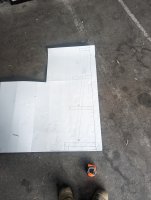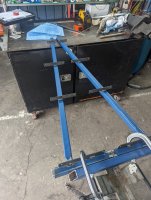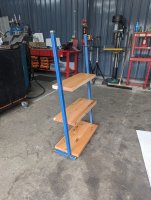Flow-Rider
Burner
Internal floating piston, it's a piston that separates the oil from air or gas.I know that to be hip and in the in crowd I should know, but what the frick is an IFP?
Internal floating piston, it's a piston that separates the oil from air or gas.I know that to be hip and in the in crowd I should know, but what the frick is an IFP?
Now now, no judgement around here. I’m sure life still has meaning and purpose. Or so they tell me.Incorrectly Functioning Penis


Brilliant explanation.Now now, no judgement around here. I’m sure life still has meaning and purpose. Or so they tell me.
The IFP, internal floating piston, is the most popular method to seperate the gas from the oil in a damper. The oil needs to be pressurised so it doesn’t cavitation during fast strokes, sit back down komdotkom.
Say you’re landing the bike from a big jump, the shock is slammed hard to full stroke. The shaft speed is very high. The shock’s damper provides some energy absorption via damping, aka resisting the pistons travel through the oil. What we call compression damping. The oil’s viscosity works in conjunction with the compression circuit to provide this resistance. When oil cavitates, it changes state from liquid to a gas. Gas has a fraction of the viscosity of oil.
Now on the rebound stroke, the spring or air can is providing maximum rebound force. The rebound damping circuits job is to slow this down, so we don’t have a pogo stick. If the gas pressure on the ifp wasn’t there, the oil wouldn’t be pressurised, and again we’d have massive, temporary viscosity loss due to cavitation, and a pogo stick.
Here is a cutaway of an old RP23 shock, with the IFP circled.
The IFP fjohn860 is talking about wasn’t in the damper side of a shock, but for a dual air chamber setup in forks. Instead of volume reducers, you can run a slave air chamber. The IFP separates the high pressure and low pressure air chambers. The main chamber, in the fork stanchion can be set at a lower pressure, for better coil like feel. The air chamber is set higher, becoming an influence on the air spring force, as the fork goes deeper into its travel.
Check here for a lovey little animation.

runt — diaz suspension design
Insert for mountain bike suspension air forks that provides a coil like feel while maintaining a lower weight, infinite adjust-ability, and lower price.diazsuspensiondesign.com

If you’ve got the patience or intelligence of which I lack both Steve from Vorsprung does brilliant YouTube vids on all sorts of nerdy suspension topics. I try but just glaze over by the halfway point or I learn something new but because my brain is only so big when something new goes in something old goes out.Brilliant explanation.
You should start a weekly “learning things with link” thread.
Yeah and it translates well to moto, I forward vorsprung vids to mates all the time rather than try and explain compression/rebound etc.If you’ve got the patience or intelligence of which I lack both Steve from Vorsprung does brilliant YouTube vids on all sorts of nerdy suspension topics. I try but just glaze over by the halfway point or I learn something new but because my brain is only so big when something new goes in something old goes out.
Definitely worth a look though.
There's also the bible... But who reads books these days .Yeah and it translates well to moto, I forward vorsprung vids to mates all the time rather than try and explain compression/rebound etc.

Bloody bible bashers!There's also the bible... But who reads books these days .

LSNEDRockwool insulation inside air moving equipment is very common - for a long time it was standard practice. The perforated facing is to improve the sound absorption qualities of the rockwool.
Yes indeed. Given all the PPE recommendations when dealing with it for wall insulation batts, I’d have assumed it was a no no for an area where it’s going to blowing air over it and into living spaces!LSNED
It should have filtering on the air ducts, but I can't imagine the condensation being a good thing for it either.Yes indeed. Given all the PPE recommendations when dealing with it for wall insulation batts, I’d have assumed it was a no no for an area where it’s going to blowing air over it and into living spaces!
Filter is to be on the main inlet - before this section…It should have filtering on the air ducts, but I can't imagine the condensation being a good thing for it either.
If a youtube video is too much for them I have little hope a textbook will help. Some people just hit the send button regardless of whats happening under them haha.There's also the bible... But who reads books these days .






